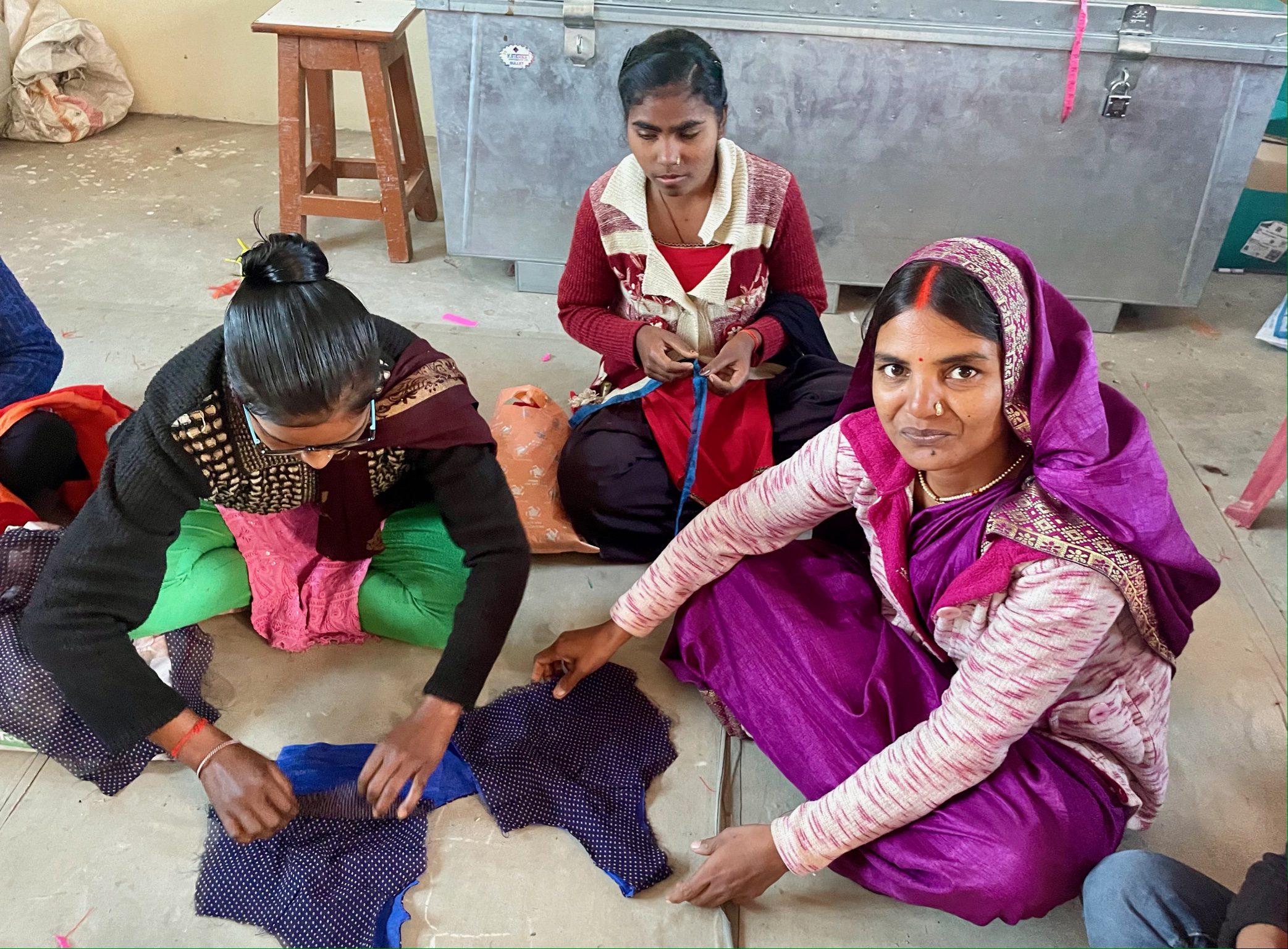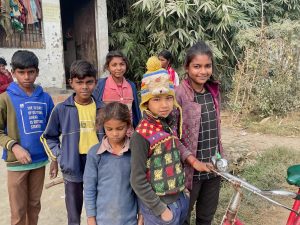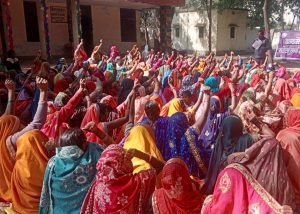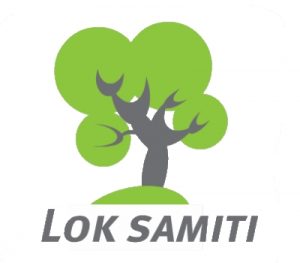
Ending Child Labor, Forced Marriage and Labor Exploitation: A Success Story from Rural India, Part 1
Photo: Women learning sewing and embroidery during the classes at Lok Samiti
This blog post is part 1 of a 2 part series by Rebekah Enoch, Program Director for Human Trafficking Search
Varanasi is a very special spiritual place for those of the Hindu faith who believe that anyone who dies in Varanasi city will attain salvation and freedom from the cycle of birth, death, and rebirth. All hours of the night and day you can witness devotees by the river Ganges worshiping, holding sacred rituals and sending off loved ones who have passed away, all in the hopes of a better future. But about 30 minutes outside Varanasi city, is a village called Nagepur (Usrapatti) where an organization called Lok Samiti is focused on improving the living conditions for people in the here and now. On a recent trip to India I had the privilege of visiting Nagepur to sit down and talk with Nandlal Master who founded Lok Samiti. By providing localized tools and support to help end modern slavery in Nagepur and the surrounding area, Lok Samiti is part of a growing movement of community-based organizations across India helping rural impoverished communities learn how to advocate for themselves and usher in a better future in the present life.
The philosophy of Lok Samiti is based on the ideology of total revolution (Sampurna Kranti or Bihar Movement), to create a “system change”, an idea first discussed by the Indian Socialist politician Jayaprakash Narayan who said the struggle against misrule and corruption in the state government was not a “movement,” but “a total revolution”. Nagepur village is located in the state of Uttar Pradesh, where locals say misrule and corruption continue to affect every aspect of their lives, disproportionately impacting the poor and preventing them from moving beyond a subsistence living. Master is a native of Nagepur village and as a young man had to drop out of college to support his family. To bring in needed income he took up silk saree weaving on a handloom in his home, a trade that his family and most of those living his village had been connected to for generations. Through this work he learned that the silk weavers, like so many across India, were in a constant struggle with bonded labor or debt bondage, and child labor. This got him thinking about how he could help end this form of modern slavery that was happening right outside his door.
End Slavery Now defines bonded labor as a process where people give themselves into what amounts to slavery as security against a loan. It is usually made to look like an employment agreement but in this type of arrangement, the worker starts work with a debt to repay, only to find repayment of the loan almost impossible due to low wages and/or extreme working conditions. This leads to essentially permanent enslavement that is sometimes passed down as debt bondage through generations. These conditions of inescapable servitude are why bonded labor is included in the definition of modern slavery globally. Varanasi is famous for their beautiful silk fabrics and sarees worldwide. In Nagepur, most of the families were weavers and lived at a subsistence level, barely making ends meet. This meant when their children were old enough, parents would either bring them to work to help pay off their parents’ debt bondage or would start a separate bonded labor contract for the child, to bring in needed income. In a 2003 report Human Rights Watch documented large numbers of bonded child workers in the Varanasi district of Uttar Pradesh in the silk weaving industry. The report estimated that 350,000 children were engaged in silk thread making and weaving in the region, working approximately 12 hours a day. Nearly all the children working on a “hired” basis were actually bonded laborers and others worked with their families who were themselves working as bonded laborers.

According to data from Census 2011, the number of child labourers in India is 10.1 million of which 5.6 million are boys and 4.5 million are girls- UNICEF, photo: Rebekah Enoch
In order to try and address this issue from a systemic level, in his off time Master started up a free school in the village for students of all ages that took place after working hours. People from ages 10 to 60 years old began coming to the school after completing a full day’s work weaving, to learn fundamental skills like reading and writing for one or two hours a day. As part of the education they received, workers also learned about their rights and the labor laws that protected them. After a few months of attending the school, Master said he started to see a change in the workers. Parents who were considering sending their children off to work realized through the process of their education, the value of receiving an education, and the power it could have for transforming their children’s futures. Fewer parents began sending their children to work as bonded laborers and instead sent them to school. Word spread about this free program and the evening classes filled up with young and old learning side-by-side, but Master recognized a gap. While attendance continued to grow, it became clear that the villagers were only allowing their sons to attend and did not want to send their female children to the classroom. Many were not sure about the value of educating girls as they would just be married off or they were afraid of the very real danger that their daughters could be stolen or sexually assaulted when walking home from class at night.
Child trafficking rates in India are some of the highest in the world, with girls being the majority of the victims. The National Crime Records Bureau estimates that in India, every eight minutes a child disappears and the number of girls working in some form of child labor in India is approx 4.5 million. When girls are trafficked, it is mainly for forced marriage, child labor, domestic help and sexual exploitation. The situation in Nagapur was no different from the rest of India, with villagers viewing marriage or manual labor as the only safe options for their young daughters. Many global studies have been done that show the value and power of educating girls. UNICEF states “Girls who receive an education are less likely to marry young and more likely to lead healthy, productive lives. They earn higher incomes, participate in the decisions that most affect them, and build better futures for themselves and their families. Girls’ education strengthens economies and reduces inequality.” Gender equity was important to Master and he made it one of the core principles of Lok Samiti, with the recognition that educating girls is foundational to reducing child labor and trafficking statistics in India and building a discrimination free society. Lok Samiti began teaching vocational training exclusively for girls during the day, in an effort to increase the girl’s independence and reduce their vulnerability to forced labor and forced marriage. In addition, gender equality and the value of educating girls was spoken about in classrooms and at events around the village to help their parents understand the value of sending the daughters to class.

Local girls who use the Lok Samiti Library recently wrote a postcards to the Chief Minister asking for better education in the village and more books for the library, photo: Panchmukhi Singh
One of the major challenges faced by those working to address bonded labor and modern slavery in India is weak enforcement of existing labor laws. India has numerous labor laws regulating the conditions of work for contract labor and child labor, and has a legislated minimum wage. Fundamental human rights that apply to labor conditions for workers are also written into the Indian Constitution. But due to corruption and a lack of funding, these rights and laws often go largely unimplemented and unenforced. It was these rights and laws that Lok Samiti wanted to ensure all the students, young and old, male and female, were aware of in order to help the workers themselves become advocates for change. According to the Global Slavery Index, India has eight million modern slaves of which bonded labor is the most prevalent. A key aspect of supporting the agency of the workers to advocate for the changes they want is education. In India, most citizens are unaware of what their fundamental rights are, the government support services available to them, and how to leverage their legal protections as citizens. Understanding the labor laws that directly affect them and how to access government protections goes a long way towards helping workers who are the most vulnerable to forced labor and debt bondage, mostly uneducated, rural and minority populations. Empowered with this knowledge they know how to avoid or escape debt bondage. Then UN Secretary-General Ban Ki-moon said on World Day of Social Justice 2014 “Experience shows that economic growth, on its own, is not sufficient. We must do more to empower individuals through decent work, support people through social protection, and ensure the voices of the poor and marginalized are heard.”

Recent meeting of Lok Samiti Women’s Group, 300 women from 50 villages attended in preparation for World Women’s Day as well and a discussion about issues for the village and the women, photo: Nandlal Master
As demonstrated by the recent protests in March 2022 across India for better pay and labor rights, there is a growing awareness of the power of informed collective action to create change for workers. In a recent webinar by Freedom United, Allison Gill, Forced Labor Director, Global Labor Justice – International Labor Rights Forum said “We think as practitioners, that collective bargaining and freedom of association are what create real remedy for forced labor.” Towards this principle, Lok Samiti began including ongoing awareness raising activities to educate youth and rural populations about labor issues and their rights, to amplify the voices of the workers themselves, especially women, and empower them to advocate for the changes they wanted in their community. With this work Lok Samiti joined an emerging community-based grassroots-led advocacy movement, growing in strength from within small, rural communities across India. “The media never talks about our resilience, activism, and leadership. Because we are portrayed as ill-fated victims, we are seen as useless, and this does not help us,” one trafficking survivor in India said in a recent article by Democracy Now. “People fail to see our courage and what we do once we are shown the way.” Lok Samiti aimed to be one of those way-showers, and began laying the groundwork to help build reliance, activism and leadership in their corner of Uttar Pradesh.
To be continued in Part 2
*Names changed to protect identity.

You can follow Lok Samiti on Facebook, email at loksamiti@gmail.com or follow Lok Samiti Founder Nandlal Master on Facebook for updates on the latest work and photos.
